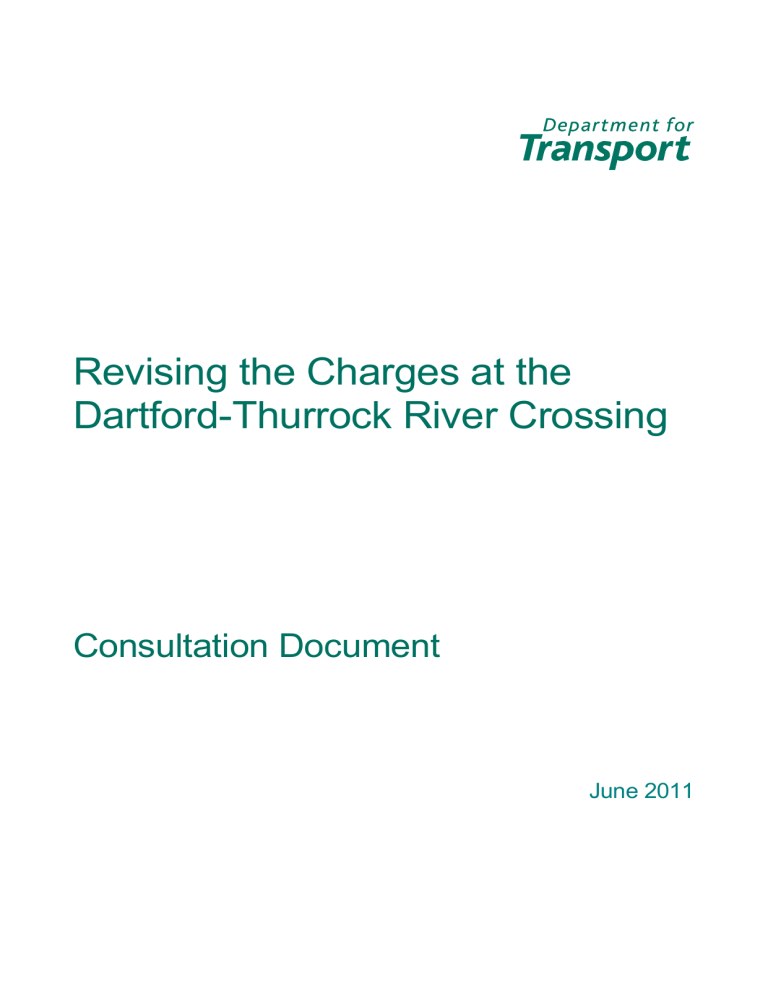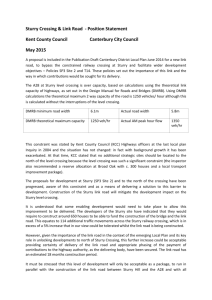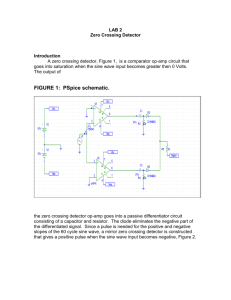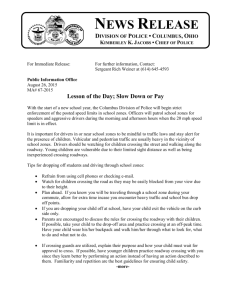Consultation document

Revising the Charges at the
Dartford-Thurrock River Crossing
Consultation Document
June 2011
Department for Transport
Great Minster House
76 Marsham Street
London SW1P 4DR
Telephone 0300 330 3000
Website www.dft.gov.uk
Crown copyright, 2011
Copyright in the typographical arrangement rests with the Crown.
You may re-use this information (not including logos or third-party material) free of charge in any format or medium, under the terms of the Open Government Licence. To view this licence, visit www.nationalarchives.gov.uk/doc/open-government-licence/ or write to the
Information Policy Team, The National Archives, Kew, London TW9 4DU, or e-mail: psi@nationalarchives.gsi.gov.uk
.
2
Contents
Executive Summary………………………………………………………………4
Wha t the consultation is about…………………………………………..4
How to respond……………………………………………………………4
Freedom of Information…………………………………………………..5
What will happen next……………………………………………………5
1. Introduction………………………………………………………………..6
2.
Context…………………………………………………………………….7
3. The Ne ed for Change……………………………………………………11
4. The Charging Proposals………………………………………………...12
The consultation questions……………………………………………………...16
Appendices
Appendix A. Impact Assessment
Appendix B. Draft Charging Order
Appendix C. Code of Practice on Consultation
Appendix D. List of Statutory Consultees
3
Executive Summary
What the consultation is about
This document sets out the Secretary of State’s reasons for proposing a new
Charging Order at the Dartford-Thurrock River Crossing. The Government is seeking views on the proposed Charging Order (see draft at Appendix B), in accordance with the Trunk Road Charging Schemes (Bridges and Tunnels)
(England) Procedure Regulations 2001 (Statutory Instrument 2001/2303).
Location of the Crossing
The Dartford-Thurrock River Crossing is a key part of the strategic road network. It consists of two two-lane tunnels carrying traffic to the north, and a four-lane cable stayed bridge (the Queen Elizabeth II Bridge) carrying traffic to the south. The Crossing spans the River Thames between Dartford and
Thurrock, forming a trunk road link (the A282 Trunk Road) in the M25 orbital motorway.
Duration of consultation
The consultation period will run until 23rd September 2011.
How to respond
If you would like further copies of this consultation document it can be found at www.dft.gov.uk/consultations/dft-2011-08/ . You are invited to respond using the online questionnaire.
Alternatively a downloadable questionnaire form is also available on our website and can be emailed to Dartford.ChargesConsultation@dft.gsi.gov.uk
or printed and returned by post to
Claudette Bagalo
Dartford Crossing Charges Consultation
Department for Transport
Great Minster House
76 Marsham Street
London
SW1P 4DR
If you would like alternative formats (Braille, audio CD, etc), please contact
Claudette Bagalo.
4
Freedom of Information
This consultation has been produced in accordance with the principles of the
Government’s “Code of Practice on Consultation” (see Appendix C).
Information provided in response to this consultation, including personal information, may be subject to publication or disclosure in accordance with the
Freedom of Information Act 2000 (FOIA) or the Environmental Information
Regulations 2004.
If you want information that you provide to be treated as confidential, please be aware that, under the FOIA, there is a statutory Code of Practice with which public authorities must comply and which deals, amongst other things, with obligations of confidence.
In view of this it would be helpful if you could explain to us why you regard the information you have provided as confidential. If we receive a request for disclosure of the information, we will take full account of your explanation, but we cannot give an assurance that confidentiality can be maintained in all circumstances. An automatic confidentiality disclaimer generated by your IT system will not, of itself, be regarded as binding on the Department.
The Department will process your personal data in accordance with the Data
Protection Act (DPA) and in the majority of circumstances this will mean that your personal data will not be disclosed to third parties.
What will happen next?
The consultation will end on 23rd September 2011. The Department for
Transport will then consider all of the representations made during this period.
A summary of the responses received and t he Department’s conclusions in light of this consultation will be published on our website www.dft.gov.uk
within three months after the consultation period has closed.
5
1. Introduction
The Dartford-Thurrock River
Crossing (‘the Crossing’) consists of two twolane tunnels carrying traffic to the north, and a four-lane cable stayed bridge
(the Queen Elizabeth II Bridge) carrying traffic to the south. Toll charges were levied until 2003 when the debts associated with the construction of the bridge and tunnels had been fully discharged.
A road user charge has been collected at the Crossing since 2003, using the powers in the Transport Act 2000, in order to manage the high demand for use of the Crossing.
The Department for Transport (DfT) revised the charging regime in 2008 following public consultation. Details of the current charging regime are set out in the A282 Trunk Road (Dartford-Thurrock Crossing Charging Scheme)
Order 2008 1 . Prices are relatively low in comparison with some other strategic river crossings. Although the Secretary of State may vary the charge in line with changes to the Retail Price Index, such changes have not been regularly made at the Crossing. This is principally because of concerns that multiple coin transactions would cause delays at the pay booths.
Amongst other things the Transport Act 2000 also provides that revenues from a trunk road user charge must be spent on transport 2 . The DfT has made clear that providing improvements to the performance of the Crossing are a priority in view of the importance of the Crossing for the movement of goods and people, and its contribution to the economy. At the spending review in autumn 2010, the Department announced its intention to increase the charges as part of a package of short, medium and long term measures for the
Crossing, including
suspension of charges to allow free use of the Crossing at times of severe congestion
introduction of free-flow charging and
review of options for additional Crossing capacity.
This is the context for the proposed changes to the current charging regime, which are set out in further detail in the next sections. The formulation of the proposals was informed by an impact assessment of alternate policy options
(see Appendix A) and the revised charging regime is set out in a draft
Charging Order (see Appendix B).
1 Statutory Instrument 2008 No. 1951
2 Transport Act 2000 Schedule 12 paragraph 13(1)
6
2. Context
Strategic role of the Crossing
The Dartford-Thurrock River Crossing is a key part of the strategic road network.
The Crossing spans the River Thames between Dartford and Thurrock, forming a trunk road link (the A282 Trunk Road) in the M25 orbital motorway. It continues to provide benefits and, therefore, there is a continuing demand for its use.
The Dartford River Crossing Study into Capacity Requirement which was published by DfT in 2009 3 , provided a comprehensive analysis of the
Crossing and noted that 22-32% of trips using the Crossing were for business purposes 4 . This proportion was significantly higher than the national average of 17% on a normal weekday between 7.00am and 7.00pm.
The 2009 study pointed to the importance of the Crossing in catering particularly for strategic movements of people and goods. For example, over
40% of journeys by light vehicles using the Crossing were relatively long distance, travelling 50 miles or more. Over 30% of HGV trips involved Dover port and particularly long distance travelling, while around half had origins and destinations within the east and south east of England. The majority of trips using the Crossing are travelling between the large conurbations to the north and south of the Crossing. Only a relatively small proportion of trips using the
Crossing were very local. For example, 6% were travelling less than 12 miles.
Current and forecast performance of the Crossing
The Crossing suffers from significant levels of congestion, with over 50 million vehicles using it each year.
The design capacity of the Crossing was 135,000 vehicles a day. However, the 2009 study concluded that the existing Crossing had been operating at its design capacity over a number of years, provided poor journey time reliability for its millions of users and offered little resilience.
At times of high demand even minor instances at the Crossing could result in further flow-breakdown, causing worsening levels of performance to users.
Congestion at the Crossing led to problems of delays, with extensive queues affecting all users.
Evidence over the last five years confirms that congestion remains a problem.
For example, the Crossing operated above its design capacity on 257 days during 2010. Data from the Highways Agency Traffic Information System shows consistently that journey times on the M25 J30-J7 section (which includes the Crossing) demonstrate average delays of between 7-11 minutes
3
2009 study is available at http://webarchive.nationalarchives.gov.uk/+/http://www.dft.gov.uk/about/strategy/capacityrequirements/d artfordrivercrossing/
4 Defined as trips for work purposes in the course of a normal business day, excluding commuting trips.
7
for the slowest 10% of journeys - among the highest level of delay on the network nationwide.
The situation is anticipated to worsen as a result of forecast traffic growth. The
2009 study concluded that the Crossing would be unable to cater for the forecast growth in traffic and predicted increases in travel demand. It concluded that the level of performance would deteriorate further.
Proposals for improvements
In recognition of the strategic importance of the Crossing the Government is committed to tackling the current and forecast performance issues affecting the Crossing. Consequently the Department has identified a number of short, medium and long term measures to be taken forward in this spending review period. The increase in charges is both a measure to manage demand and will help to fund transport investment.
Suspension of charges at times of severe congestion
Ministers have made clear that the suspension of charges is an option in emergency situations. So, for example, suspension may occur at times of congestion when the level of severity is such as to constitute an emergency, especially where the process of the collection of the charge is adding to the delays. Suspension will enable action in response to the emergency.
The Highways Agency have developed an operation protocol which sees the suspension of the charge when circumstances are such as to amount to an emergency. Situations are to be considered on a case by case basis. In such circumstances, the charge would be suspended in either one or both directions until such time as traffic conditions return to agreed levels. The protocol is to be trialled for six months from 1 st July 2011.
The act of suspension of the charge will result in a loss of charge revenue for the Department but Ministers are prepared to forego such revenues in these exceptional circumstances.
The use of newer charging technology
Current arrangements largely involve drivers being required to stop and pay the road user charge within a barrier plaza environment at the Dartford
Crossing. The current collection process has been used since the early
1990’s, and provides for a mixture of payment methods. The majority of payments for the crossing charge are cash-based, with almost 70% of payments made by cash compared with around 30% made by Dart-Tag account.
Over the last decade, there has been a vast improvement in the technology being used to collect road user charges, not only in this country, but around the world. The Department has made clear that the priority for improvements
8
to the operational performance of the Crossing is the introduction of newer technology to deliver a free-flow charging option for collection of the road user charge.
The Highways Agency is developing options and the business case for the implementation of such an arrangement at Dartford. The introduction of free flow charging provides the opportunity to re-design the road layout to improve the flow of traffic, thereby reducing delays and providing a better service to road users. The new charging option would see the introduction of new payment methods for pre-registered users of the Crossing, physical lay-out changes and the use of automatic number plate recognition cameras to enable free-flow charging at the Crossing. The Highways Agency will lead on the delivery of a free-flow charging option. The Department is committed to introducing free flow charging by the end of 2013, as set out in the
Departmental Business Plan.
Future additional crossing capacity
The 2009 DfT study into current and future capacity constraints at Dartford
Crossing recognised that although some improvements could be made to the performance of the Crossing in the short and medium term, the main cause of the congestion at the Crossing is its physical capacity, and ultimately, there is a need to provide additional crossing capacity.
Ministers have made clear that they accept the case for additional capacity and are committed to the development of future crossing options. They confirmed that the Department would review the potential crossing options identified in the 2009 report and would be able to take forward the development of such possible options funded by crossing charges.
The future crossing options being reviewed are:
At the site of the existing Dartford-Thurrock River Crossing
Between the Swanscombe Peninsula and the A1089
Between the east of Gravesend and the east of Tilbury
The Department will commission the work necessary to develop the potential crossing options in more detail. This would allow an assessment of their potential costs, but also of their merits in terms of the benefits brought by the provision of additional capacity, and their impacts in terms of adverse repercussions on the environment and potential increases in carbon emissions.
The development and review of future crossing options is a major undertaking by the Department. The first phase of design, cost estimating, traffic modelling and economic and environmental assessment is planned to take around 12 to
18 months to complete. This assessment will allow merits and potential disbenefits of the proposed options to be considered as part of a public consultation process to gather views on the most appropriate option to pursue.
The Department will subsequently incur substantial costs in developing and implementing the selected option. The 2009 Dartford River Crossing Study
9
into Capacity Requirement suggested that the cost of additional Crossing capacity alone could be in the order of £1-£7 billion.
10
3. The Need for Change
The current charges have been in place since November 2008, which was the first time they were revised since their introduction as a road user charge in
2003.
Even at the current rates of charge, congestion at the Crossing remains a daily occurrence, and forecasts show that this will increase further over time.
The main cause of congestion at the crossing remains the level of traffic wishing to make use of it, combined with the physical constraints of the existing Crossing. The Crossing is still one of the most congested links on the strategic road network and without taking action to manage demand there is a continued risk of increased congestion.
Government had to make hard choices at the time of the 2010 spending review. The outcome was that the DfT accepted the need to raise additional revenue both from increasing the cap on rail fares and from the Dartford
Crossing charges.
Recognising the importance of the Crossing and accepting the need to raise additional revenue from the Crossing, the Department was able to prioritise expenditure during this spending review period for short, medium and long term measures to improve flow at the Crossing. These included
suspension of charges to allow free use of the Crossing at times of severe congestion
introduction of free-flow charging which will require capital investment to reconfigure the infrastructure and build back-office systems at the
Crossing, and
review of options for additional Crossing capacity - undertaking a comparative economic evaluation of the three schemes identified previously would be the first step in the process of developing a full business case for the construction of additional capacity.
The proposed increased charges at the Dartford-Thurrock River Crossing, and the subsequent increases in net revenues from charge receipts, would allow the Department to continue to prioritise up front investment in measures at the Crossing in the short and medium term and in developing and funding additional crossing capacity in the Lower Thames area in the long term.
11
4. The Charging Proposals
In developing these proposals, Government has taken a number of factors into account:
(a) Prior to the implementation of a free-flow charging scheme which makes better use of newer charging technologies, there is a need to keep cash transactions as simple as possible. Rounding prices enables the payment to be made more easily and avoids increasing the time taken for the transaction.
(b) In order to facilitate a move to non-cash (account) payment methods prior to the introduction of a free-flow charging scheme, there is a need to encourage further take-up of Dart-Tags.
(c) There is a need to maintain the fairness of the Crossing charge for local residents who continue to suffer the adverse effects of the Crossing in their vicinity.
The Government therefore proposes to:
(a) Increase the charges in two successive steps to assist users in adjusting to the overall increase
(b) Increase the charge rates for cash payments by approximately a third within those two successive steps, rounded to the nearest 50p to keep transaction costs low.
(c) Apply existing discount levels by category of vehicle for those choosing to pay in advance using Dart-Tag
(d) Retain the other elements of the current charging regime at least until such time as newer charging technologies are introduced.
Charge rates
Proposed increases
Subject to consideration of the consultation responses the proposal is to implement the first increase once the process of consultation and finalising the Order is completed. This is estimated to be late 2011. The second increase would then take effect in spring 2012, taking account of the need to avoid public holidays when traffic volumes are likely to be greater and the desirability of tying in with the new financial year.
12
The proposed charge rates are set out in the table below:
Dartford Crossing Day Charges (6am-10pm)
Note: no charges apply 10pm-6am
Motorbikes
Cash charge
Cars
2 Axle Goods
Multi Axle Goods
Dart-Tag charge
Cars
2 Axle Goods
Multi Axle Goods
Current
Free
£1.50
£2.00
£3.70
£1.00
£1.75
£3.20
2011
Proposed
2012
Free
£2.00
£2.50
£5.00
£1.33
£2.19
£4.33
Free
£2.50
£3.00
£6.00
£1.67
£2.63
£5.19
The comparative assessment of impacts of alternate options (see appendix A) shows that greater improvements in travel times would be secured by the increases proposed in the above table than could be achieved by increasing the charges in line with the Retail Price Index.
The increase in charges reduces congestion by dissuading some road users from using the congested crossing. The consequent reduction in congestion is a benefit to all remaining users of the Crossing. Overall the value of the time and fuel cost savings they experience exceeds the costs borne by those who decide against using the Crossing after the charge increase.
The assessment also confirmed that the above charge increases would generate more revenue for transport investment (estimating an annual average increase in revenue of £19.9million over five years), than could be gained from increasing charges in line with the Retail Price Index.
Other operational aspects
The Department intends to retain other details of the charging regime unchanged at least until such time as the free-flow charging scheme and the use of newer charging technologies are introduced.
Discounts for Dart-Tags
13
Discounts from the level of cash charge at the Crossing are provided currently to all vehicle classes where users have pre-paid the relevant charge through the Dart-Tag system.
DfT recognises the important role of pre-payment in bringing about shorter transaction times at the Crossing. This helps maintain better traffic throughput. Therefore, DfT intends to maintain the existing level of discount to such users, to continue to encourage the use of Dart-Tag. It will also help to prepare users of the Crossing for the introduction of free-flow charging technology at the Crossing. There is a higher discount rate for cars (33%) than for other vehicles (12.5-13.5%) as the take up of Dart-Tag accounts is proportionately lower among car drivers. Currently only 23% of car trips across the Crossing are paid in this way compared with approximately 40% of vans and 70%of HGVs.
Discounts for local residents
In amending the charging regime at the Crossing in 2008, and following public consultation, the Department introduced enhanced discounts for local residents of Dartford and Thurrock. Private car drivers registered on this discount scheme are entitled to 50 free crossings, followed by a discounted crossing charge of 20 pence per trip.
Since 2008, the take-up of the discount for local residents has been less than anticipated. Only around 20,000 residents are taking advantage of the discounts, although over 150,000 residents are potential car drivers and therefore eligible for the discount. This is despite a concerted effort by the
Highways Agency and the Crossing operator to raise awareness of the discounts available.
Analysis of the number of trips using the Crossing for very local journeys shows that the number of such trips made is minimal. Only 6% of all trips (5% for cars and vans, and 8% for HGVs) use the Crossing for journeys less than
12 miles.
Despite this relatively low usage, the Department recognises the importance of providing residents within the immediate vicinity of the Crossing with a discount in relation to the charges levied, and are keen to see take-up increase.
The Department therefore proposes no changes to the current number of free crossing trips available to local residents, no change to the current levels of discounted charge and no change to the annual £10 administration fee.
Vehicle Classifications
The DfT is making no proposals to amend the current arrangements of vehicle classification in use at the Crossing. Vehicle classification is presently in line with the Road User Charging and Workplace Parking Levy (Classes of Motor
Vehicles)(England) Regulations 2001. These regulations set out the classification of vehicles for charging schemes in place under the Transport
Act 2000.
14
Exemptions
Similarly, the DfT do not intend to make any amendments to the current list of classes of vehicles exempt from the Crossing charge.
Provision for discretionary power to vary charges in line with RPI
The current 2008 Charging Order includes the provision for charges to be varied in future in line with changes to the Retail Price Index (RPI).
The proposed Order includes provision to allow changes in line with RPI to talk place in the future. The percentage by which charges can be varied will be by reference to the RPI percentage change determined over a period of 12 months. It remains open to the operator to vary the charge at a lower percentage change than this. Variations may take place no more than once a year and the discretion remains to make no variation in line with RPI.
15
Consultation Questions
The Department will consider all views in reaching its decision. Any changes to the charging regime and operation of the Crossing have to meet the aims of managing the high demand on the Crossing, and raising revenue to help invest in transport measures.
Changes to the charging regime should also be deliverable in a safe and practical way.
You are invited to consider the following questions when responding to the consultation,
Proposed charges
1. Do you agree or disagree with the approach of increasing the charges for cash payments for all categories of vehicle by broadly equivalent rates?
2. Do you agree or disagree that current rates of discount should continue to apply for Dart-Tag account holders?
3. Do you agree or disagree with the approach of introducing changes in 2011 and 2012?
4. Do you have specific comments on the draft Order (at Appendix B)? If so, please add.
Other aspects of the charging regime
5. Do you agree or disagree that the current terms of the Local Residents
Discount Scheme should remain unchanged?
6. Do you agree or disagree that other details of the charging regime (i.e. times of operation, vehicle categories and exemptions) should remain unchanged?
Impacts of the proposals
7. Do you agree or disagree with our assessment of the impacts of the proposals particularly on small firms and protected equality groups?
Please provide as much supporting evidence as possible with each of your responses to the above questions.
16







